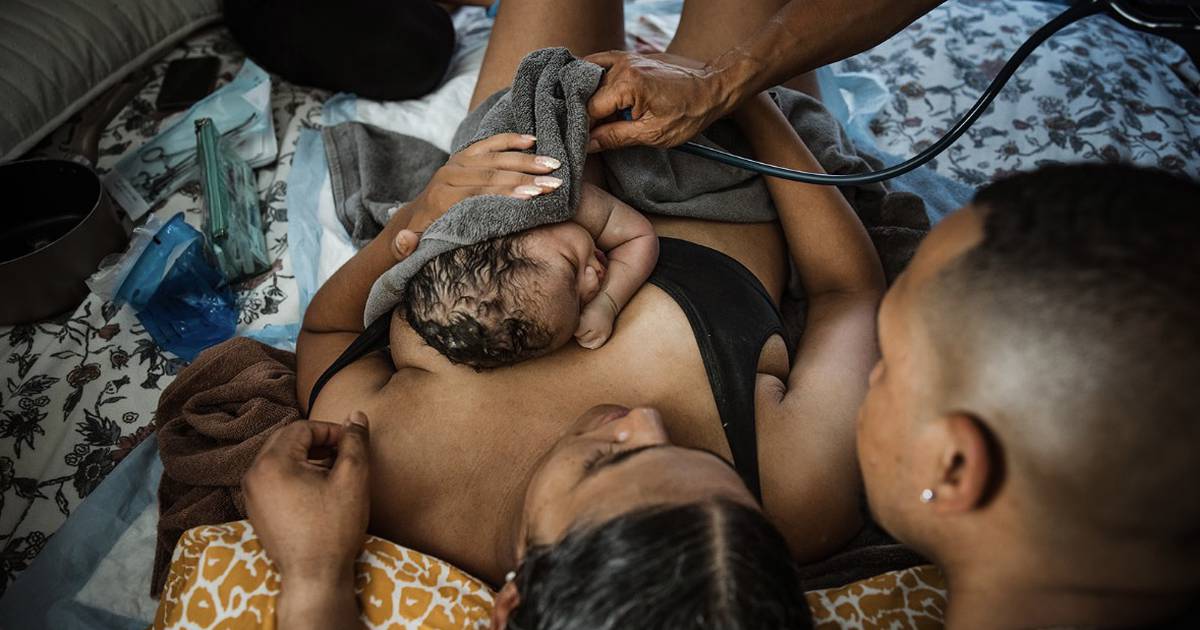
Black women are dying at almost three times the rate of white women during or after pregnancy. Researchers say there’s work to be done to combat this crisis— within medical institutions, but also in American culture at large.
The maternal mortality rate for Black women was 2.6 times the rate of white women in 2021, according to data released by the Centers for Disease Control and Prevention’s National Center for Health Statistics.
Data recorded since 2018 shows the crisis is worsening each year, as Black women continue to face the brunt of medical disparities.
Pregnancy related deaths for Black women rose 26% from 2020 to 2021, with women 40 and older affected the most. Maternal mortality is defined by the World Health Organization as death while pregnant or within 42 days of the end of pregnancy.
Tyan Parker Dominguez, teaching professor in the Suzanne Dworak-Peck School of Social Work at USC, said the high Black maternal mortality rates are a consequence of long-standing racial disparities.
“It’s not novel in the sense that there’s a disparity, it’s just another health outcome that not surprisingly shows this persistent, disproportionate burden of ill health on the African American community,” she said.
Los Angeles County is widely representative of the national maternal death data. Black women have a tripled risk of maternal mortality in LA County, according to a California Department of Public Health long-term analysis.
In February, the Los Angeles County Board of Supervisors approved a motion by county Supervisor Holly J. Mitchell to begin creating a doula hub to increase access to a diverse network of doula service providers. Doula care services aid in decreasing the rates of preterm and cesarean births, postpartum depression symptoms, and the need for medical pain control during labor, according to the motion.
California’s Medi-Cal doula care benefit authorizes all pregnant women to receive prenatal and postpartum care.
According to the County of Los Angeles Public Health, there were over 96,000 births within LA County, and 41% of those births were covered under Medi-Cal. Although building a doula hub would support thousands of births each year, finding funds to sustain the services of doulas is still an obstacle. Assistant Health Deputy Jessica Jew from Mitchell’s office said that doulas would be paid about $1,000 less than their usual income to provide their services under the Medi-Cal program.
“It’s not sustainable nor affordable for someone to make a living if they are being chronically underpaid,” Jew said. “One of the issues we are wrestling with is how grant-funded initiatives are a big disparity in terms of what doulas could command in Medi-Cal reimbursements.”
Jew said that a staff analyst position is also needed to coordinate the activities of the hub and serve as a point of contact for managed care.
Doula advocates are needed for Black women who experience traumatic, life-changing situations due to systemic racism and biased health care systems, she said.
“Having a doula who understands and has seen this several times before can help to raise issues and teach you the vocabulary of what to say and how to advocate for yourself,” Jew said. “In some cases they can be that front-line person who can go between and navigate the health care system either with you or on behalf of you.”
Within the medical system, Black women are impacted by both access to care and the quality of care.
“In our society, we’ve highly medicalized pregnancy,” USC Professor Dominguez said. “And our medical system is not a universal system. So, we certainly have disparities in access to care because of how our system is set up.”
Dominguez noted that access to prenatal care, especially within the first trimester of pregnancy, is core to identifying and monitoring pre-existing health conditions which can create adverse birth effects.
Black women are more likely to have pre-existing health conditions going into a pregnancy, which may put them at higher risk during the pregnancy, Dominguez said. Cardiovascular health concerns like higher blood pressure might not be known to the patient before their pregnancy, but can result in adverse outcomes.
Socioeconomic disparities rooted in American cultural biases can inhibit access to monitoring these conditions. But, despite an expecting mother’s access to private medical insurance, Black women are receiving an overall lower quality of prenatal care, Dominguez said.
Less routine interventions, less information and more stereotyping affect the quality of care by healthcare providers. And, implicit bias might contribute to the silencing of pregnancy concerns from Black mothers.
According to the National Institutes of Health, medical providers are less likely to identify facial expressions displaying signs of pain in Black patients, unlike their non-Black counterparts, which ultimately allows the severity of their pain to be ignored.
“Ignoring, for example, their preferences and complaints of pain or of something not feeling quite right, their concerns are being dismissed,” Dominguez said.
She said educating medical students on the social determinants of health can bring awareness to the Black maternity mortality crisis.
“There are the factors that affect how we live, breathe and move in the world that shape what our health is like,” Dominguez said. “So it’s not all on the medical community, why these disparities exist, but they show up in their emergency rooms and their delivery rooms.”
Medical professionals could be exposed to implicit bias as early as medical school.
Cynthia Sanchez, teaching associate professor in the Suzanne Dworak-Peck School of Social Work at USC, said that there are not enough conversations surrounding cultural humility and how it contributes to personal bias.
“I think as educators for medical schools, we all need to look at our curriculum and look for where we are teaching bias and what we are doing to make people think differently about other groups of people in the first place,” Sanchez said.
So, USC’s Department of Nursing program has eliminated race from the case studies students see in their curriculums. “Decolonizing” the curriculum, Sanchez said, helps remove racial bias in the classroom.
California has installed various programs to combat Black maternal mortality such as state- and Medicaid-funded Black Infant Health that offers group or individual counseling for Black mothers. In addition to the Black Infant Health Site in Los Angeles, the LA County of Public Health department subcontracts with four other agencies to provide birth services in other locations across the county.
On a global scale, the United States ranks the highest in maternal mortality rates among 11 industrialized countries. In 2018, the maternal mortality rate in the United States was 17.4 per 100,000 live births, according to data from the Organisation for Economic Co-operation and Development.
The industrialized country with the second highest maternal deaths is France, with a rate half of the United States: 8.7 deaths per 100,000 live births.
“Other countries have much better pregnancy outcomes, one reason being different cultural attitudes around pregnancy and childbearing,” USC Professor Dominguez said. “Where family is central and pregnant women are more taken care of, these attitudes that favor pregnancy there is better support and concerned around taking care of pregnant women.”
Contributing reporter: Arun Cherukuri
Data was produced by the National Vital Statistics System. We obtained this data from the CDC’s National Center for Health Statistics, which wrote an online report. Maternal mortality rates, the number of deaths per 100,000 live births, were calculated by the National Center for Health Statistics. Additional calculations were made to compare the maternal mortality rates by race; we did this by dividing the maternal mortality rate for Black women by the maternal mortality rate for white women. International data was sourced from The Commonwealth Fund, which wrote a report on the health statistics produced by the Organization for Economic Co-operation and Development.




